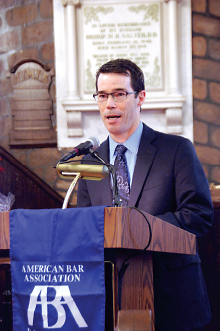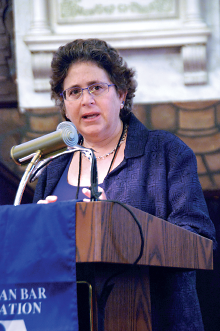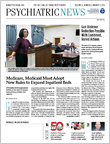Many Americans feel helpless in the face of the annual toll of homicides and suicides involving firearms and believe that nothing can be done to keep guns out of the hands of people who wish to harm themselves or others.
However, a combination of public health and legal approaches has demonstrated utility on reducing gun deaths and injuries, said speakers at a conference on reducing gun violence last month at the Mother Emanuel A.M.E. Church in Charleston, S.C.
Were gun violence an infectious disease, it would be a major public health problem, noted Daniel Webster, Sc.D., M.P.H., a professor of health policy and management and director of the Center for Gun Policy and Research at the Johns Hopkins Bloomberg School of Public Health in Baltimore. Firearms account for about 11,000 homicides and 21,000 suicides every year, he said. An estimated 74,000 people suffer nonfatal injuries.
“Gunshot wounds are the leading cause of death for males aged 15 to 24 years and the second leading cause for those 25 to 44 years,” said Webster. “And firearms homicide is the second leading cause of the black/white difference in life expectancy.”
Firearms injuries should be seen in the same light as Ebola or influenza, starting by studying the risk in different demographic groups and across space and time, he said. “Then you have to look at the ‘agent of injury’ and think about how we can make guns less lethal and less available in high-risk situations.”
The biggest potential gains in reducing gun violence lie in two areas, he said: enforcing higher standards for legal gun ownership and increasing accountability of gun sellers and purchasers.
Webster and others favor universal background checks for gun purchasers, including sufficient waiting periods. Current federal law states that if the gun dealer hasn’t heard within three days from the FBI about any disqualifications, the sale can go through. That was the case for Dylann Roof, accused of shooting and killing nine worshippers and injuring another at Mother Emanuel A.M.E. Church, the site of the conference, on June 17, 2015.
Roof should have been prevented from buying guns because he admitted to a misdemeanor charge of possession of narcotics, but the FBI did not reply in time and the sale went through. California has a 10-day waiting period, but that can be extended to 30 days in some circumstances.
Less formal approaches may be harder to quantify, but show some promise, as well. Getting ex-felons or gang members to talk to young men about avoiding violence has been tried in several cities, but the effects have proved uneven because of implementation challenges and inconsistent fidelity to the model.
“We do see a pent-up demand for someone external to set up rules that make them safer,” he said. “Shooting someone may lead not only to jail but also to revenge from the victim’s family or friends.”
William Settles, J.D., the U.S. attorney for South Carolina, intervenes when juveniles are released from custody to remind them of the consequences of breaking the law again.
“We focus on who to lock up and who to get into help,” said Settles. “We bring in law enforcement but also social services.”
Guns that end up in the hands of violent criminals may be stolen from homes or cars, but many are sold originally by gun dealers. Gun dealers should be suspicious when purchasers use large sums of cash or buy several guns at one time, or both. These may be straw purchases, in which criminals obtain guns by using buyers who pass the background check.
Ninety percent of guns used in crimes are sold by 5 percent of gun dealers, so targeted enforcement can have a significant effect, said Kelly Sampson, J.D., coordinating attorney for Lawyers for a Safer America at the Brady Center to Prevent Gun Violence.
The worst was Badger Guns and Ammo in West Milwaukee, Wis., which allegedly sold more crime guns than any other dealer in the nation. In October 2015, a jury found Badger liable for gunshot injuries to two Milwaukee police, awarding them $6 million. The gun was bought by a straw purchaser. The case is now on appeal but, if upheld, may open a new door to extend responsibility for misuse of guns to those who supply them.
Two natural experiments show how laws have helped or hindered the fight against gun crime, said Webster.
Repeal of Missouri’s permit to purchase law in 2007 led to a doubling of guns diverted to criminals, and the percentage of crime guns originating in Missouri and transported to other states increased too.
In Connecticut, a 1995 law tightening restrictions led to 40 percent fewer homicides and 15 percent fewer suicides.
While Congress is unlikely to pass laws that might usefully curb gun violence, action in the courts or in state legislatures is more promising, said Juliet Leftwich, J.D., legal director of the Law Center to Prevent Gun Violence in San Francisco.
“The National Rifle Association argues that any gun law violates the Second Amendment, but the controlling Supreme Court ruling [District of Columbia v. Heller, 2008] actually construes the right to individual ownership of firearms quite narrowly, limiting it for ‘law-abiding, responsible private citizens to own a gun in the home,’ ” said Leftwich.
However, Congress has placed many obstacles in the path of reasonable regulation of guns, she said. “You can’t sue the manufacturers, or register guns like cars, or apply product-safety legislation.”
Nor is the Centers for Disease Control and Prevention permitted to conduct research into gun violence. Other legislation prevents the federal Bureau of Alcohol, Tobacco, Firearms, and Explosives from revealing data tracing the passage of guns through the system, although police departments can release such information. However, states can enact stricter laws, and so far 93 percent of cases challenging them have been rejected by the courts, she said.
“Gun laws need political courage and public support,” she said. “We won’t get change unless we demand it.” ■
The conference website for “Moving From Crisis to Action: A Public Health Approach to Reducing Gun Violence,” which includes speakers’ slides and other resources, can be accessed
here.



